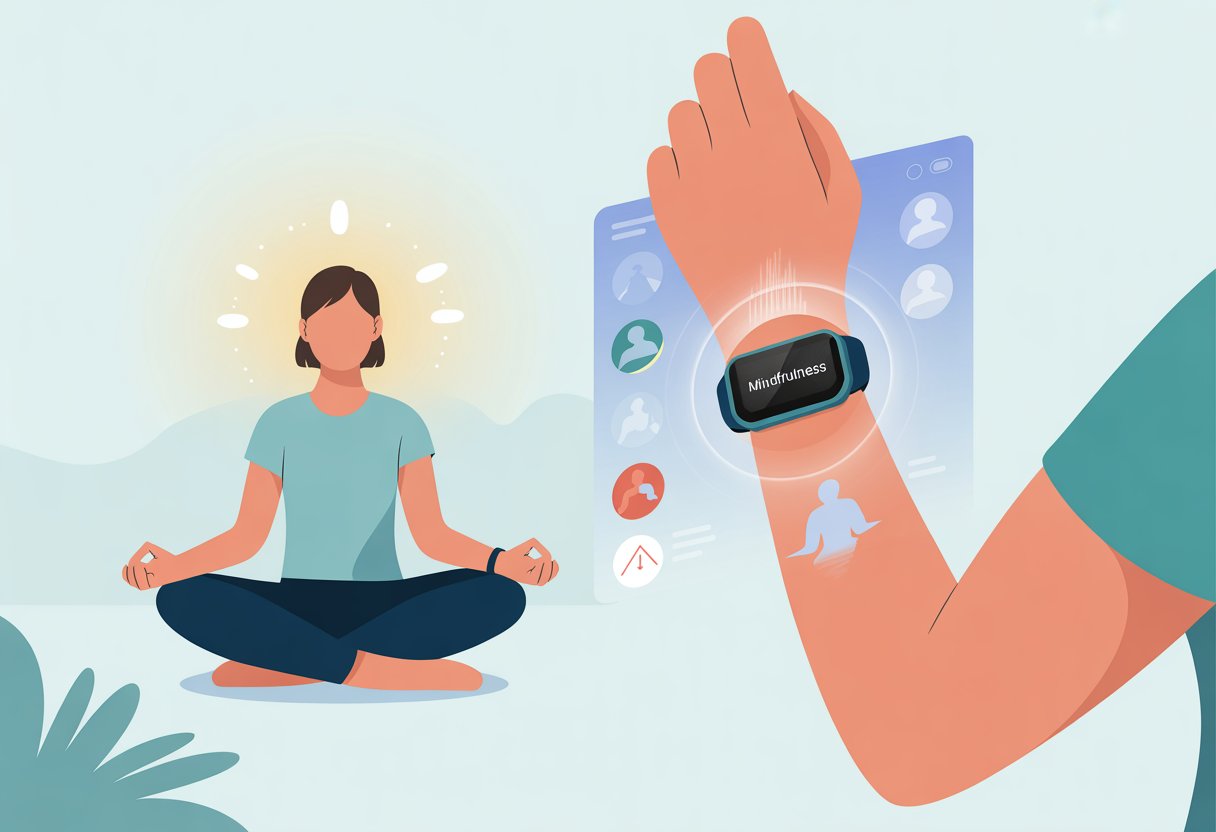We’ve all been there—settling in for a deep breathing session, hoping for a little peace, and then… our fitness tracker just ignores us. Did we meditate, or did we just doze off pretending to meditate?
When our fitness tracker skips logging mindfulness sessions, it’s usually because the device doesn’t support or automatically track that session type.

Sometimes, those fancy features like Breathe or Mindfulness don’t actually sync or show up in the app. That can make us wonder if our calm vibes even registered. It’s easy to start questioning if our “chill time” counts at all, especially when the tracker still thinks we’re high-strung robots.
If you’re looking for answers—or just a little sympathy—know that you’re not the only one in this Zen-less struggle.
Understanding How Fitness Trackers Track Mindfulness Sessions
Let’s talk about the magic (okay, mostly science) that helps our fitness trackers figure out when we’re trying to find inner peace. Sensors play detective, apps try not to confuse yoga with nap time, and our heart rate gets a starring role.
The Role Of Sensors In Mindfulness Tracking
Fitness trackers rely on a mix of sensors, especially the accelerometer and heart rate monitor. The tracker tries to figure out if we’re moving or not, and if we’re still, it assumes our mind must be busy.
The accelerometer checks for movement—or, ideally, a lack of it—during mindfulness sessions. If we fidget too much, it might not log the session.
The optical heart rate sensor shines a light through our skin and measures blood flow. If it picks up a steady heart rate with little movement, the tracker decides, “Yep, this person is meditating… or maybe sleeping.” Mindfulness apps sometimes help by guiding the tracker to log things more accurately.
We just hope that combo doesn’t mislabel our relaxation as laziness.
Differentiating Mindfulness From Workout Modes
Mindfulness tracking isn’t the same as workout tracking—unless our workout is just sitting and breathing. Workout modes look for movement, steps, calories burned, or heavy breathing.
During mindfulness sessions, we’re not running or jumping. At least, I hope not. Instead, we’re focusing on breathing, being still, or maybe listening to someone talk softly about clouds.
Fitness trackers use special features for mindfulness so our meditation doesn’t look like a failed run. These features usually include app guidance and prompts to start or end a mindfulness session.
Some devices need us to tap the “Mindfulness” button in the app, like Fitbit’s help page explains. If we use meditation features on our watch but the app can’t track them, we probably need to start the right mode—not just daydream and hope for the best.
Heart Rate Monitoring During Meditation
Heart rate monitoring is a big part of how fitness trackers spot meditation. When we meditate, our heart rate usually drops, showing our body is relaxing.
The tracker keeps an eye on our resting heart rate to spot these calm moments. Lower heart rates often signal we’re actually doing the mindfulness exercise, not just scrolling our phone quietly.
Many trackers show a heart rate chart during each session. This helps us see if we’re making progress lowering stress. But if the heart rate sensor can’t get a good reading—maybe our hands are cold or the tracker’s too loose—it might not log the session at all.
That’s one way to keep us on our toes… or at least on our meditation cushion.
Common Reasons Your Fitness Tracker Isn’t Logging Mindfulness
Let’s be real—sometimes our fitness trackers just forget things. Mindfulness sessions can disappear for reasons like tech hiccups, skipped updates, or just plain human error.
Software Glitches And Bugs
Every piece of tech has its drama, and our fitness trackers are no exception. Bugs in the app or device can make mindfulness sessions vanish into thin air.
We end up staring at our dashboard, confused, wondering if we ever even sat still. Sometimes the app loads halfway, or it crashes just before saving our precious few minutes of deep breathing.
Fitbit users have found that sessions sometimes don’t log because something just goes wrong behind the scenes.
We can’t always predict it. A feature that worked yesterday might break after an update or just randomly on a Tuesday. Restarting the app or device, or force-closing and reopening, can sometimes kick things back into gear.
Outdated Device Firmware
Firmware is like our tracker’s brain—if it’s outdated, so are our stats. Skipping updates means features might not work right, including mindfulness tracking.
Old firmware might not recognize newer mindfulness features or could ignore sessions completely. Manufacturers patch bugs and improve tracking with updates.
If we’re running ancient software, the tracker might think meditation is just a nap.
We should check for updates at least once a month. Keeping both the tracker and its app up to date saves us from lost sessions and invisible health data.
User Error And Forgotten Setups
Sometimes, we’re the problem. We might forget to start the mindfulness session on the tracker or think closing our eyes is enough.
Certain devices only log sessions if we follow all the steps—like choosing a specific guided meditation or hitting “start” before zoning out. Some trackers only count specific in-app content, like built-in meditations, toward our stats.
If we use third-party apps or just sit quietly, the tracker might not notice, as Reddit users have pointed out on tracking mindfulness limitations.
A quick checklist helps:
- Start the session from the tracker or app
- Follow the full process, including any end prompts
- Double-check the mindfulness tile for results
It’s not always the tech’s fault—sometimes, we just need to pay a little more attention.
Brand-Specific Issues: Fitbit, Apple Watch, And Garmin
We expect our fitness trackers to log every mindful breath. But some devices get picky about zen. Let’s see what can go sideways with Fitbit, Apple Watch, and Garmin when we try to log mindfulness sessions.
Fitbit And Mindfulness Incompatibility
With Fitbit, mindfulness tracking sounds easy—breathe in, breathe out, and the device handles the rest. In reality, Fitbit only gives us “mindfulness” credit for certain guided sessions in their app.
If we use third-party apps or basic breathing exercises, it doesn’t always count. We can meditate for hours, but sometimes Fitbit throws shade and says we did nothing.
Some community users report their mindfulness sessions not logging at all. The trick seems to be sticking to the built-in guided options for the tracker to notice our inner peace.
Key issues:
- Only built-in sessions track reliably
- Outside mindfulness apps might not sync
- Glitches can cause sessions to not log at all
Apple Watch Mindfulness Features
If we use Apple Watch, mindfulness is called Mindfulness (no surprises there). The watch tries to log every deep breath—as long as we use their Breathe or Reflect features.
If we get creative and use third-party mindfulness apps, our Apple Watch doesn’t always recognize the effort. Troubleshooting can get wild: we might need to check Privacy options, Fitness Tracking, and even Location Services on our iPhone.
If we miss a step, our session might get ignored. Getting Apple Watch to play along sometimes feels like raising a picky pet: the right conditions, or no points.
Make sure:
- Breathe/Reflect features are used for proper tracking
- Settings are enabled: Privacy, Fitness Tracking, Location Services
- Some apps don’t count toward mindfulness rings
Common Garmin Mindfulness Challenges
Garmin deserves a namaste for trying, but mindfulness tracking can still be tricky. Most Garmin watches track stress and heart rate changes, so we might think all our meditation is counted.
In reality, only specific activities, like the built-in Relax timer, log as mindfulness. Anything outside the Garmin Connect app’s list is treated like napping on the couch: relaxing, but not trackable.
Garmin loves data, but it’s not always clear where our peaceful minutes go. Sometimes, sessions show up in Stress or Body Battery, but not as mindfulness.
We’re left clicking around menus, muttering, “it was a valid meditation, I swear!”
Common blips:
- Only built-in Relax activity counts
- Third-party meditation isn’t always logged
- Mindfulness might be hidden under Stress, not Mindfulness
App And Device Syncing Problems
Sometimes our fitness trackers act like they’re on a digital coffee break, especially with mindfulness logging. Let’s take a closer look at why syncing goes sideways and how our iOS devices and other apps can cause mix-ups.
Syncing On iOS Devices
We trust our iPhones and Apple Watches to keep things in sync, but syncing issues pop up way more often than we’d like. Sometimes, the Apple Health app and fitness tracker just won’t talk to each other.
If Mindful Minutes aren’t showing up, there’s a good chance the connection broke somewhere. One quick fix is to double-check permissions.
We should make sure our fitness tracker app has “write” and “read” access for Mindfulness in Apple Health settings. If that looks right and data’s still missing, logging out and back in can help—a tip plenty of frustrated Apple users have shared.
If nothing else works, unpairing and re-pairing the tracker is the digital version of turning it off and on again. Miscommunication between gadgets doesn’t just mess up our mindfulness count.
If we’re chasing fitness goals that depend on accurate records, every lost session feels like a personal betrayal from our wrist buddy.
Third-Party App Interference
We all love our apps, right? But every time we add a new one—like a meditation timer or a sleep tracker—it’s a bit like tossing more people into a group chat. Sometimes, these third-party apps jump in and “help” by taking over tracking, which just confuses our regular fitness app. It’s honestly the digital version of too many cooks in the kitchen.
Apps like Balance or Insight Timer might disconnect or override our main app’s sync settings. If our Fitbit or Apple Watch data isn’t logging, we should check which third-party apps have access to our health data. A quick peek at settings can help us spot any uninvited guests and change their permissions.
Here’s a quick checklist for third-party app interference:
- Review Health app permissions for each app.
- Remove or limit access for apps not in use.
- After changes, force a sync or restart our devices.
For a smart guide on troubleshooting mindfulness syncing, check out tips from Apple Watch session sync issues.
Maximizing The Accuracy Of Mindfulness Tracking
Let’s be honest, our fitness trackers sometimes act like moody teenagers—they just don’t always listen. If we want our mindfulness exercise sessions to count, a few simple steps can help keep them on track. Getting accurate stats can even help us spot trends, like how many calories we’re definitely not burning while meditating.
Proper Device Placement For Accurate Readings
If our tracker thinks it’s on a roller coaster, we’re not getting good data. Wear the device snugly, but not so tight our wrist blushes.
A loose band can throw off sensors, and then we miss out on “mindful minutes.” When sitting, let our arm rest naturally—no dramatic yoga poses just for the watch.
If the device sits too high above the wrist bone, heart rate sensors might get confused and log a nap as an intense workout. No calories tracked for that, unfortunately.
During a mindfulness exercise, keeping still helps the sensors lock in, so let’s resist the urge to wave at imaginary butterflies.
Tip:
Give the tracker’s sensor a gentle wipe before sessions. Sweat, dirt, or even yesterday’s cheese puff dust can mess up readings. A cleaner sensor means better results and fewer mysterious gaps in our logs.
Selecting The Right Mindfulness Exercise Mode
Not all trackers have a special “inner peace” button, unfortunately. We need to find and use the correct mindfulness or meditation feature—not just any breathing timer or general workout mode.
If we pick “Yoga” for meditation, our tracker might expect us to start doing headstands for endurance and calories. Spoiler: the only thing high is our heart rate.
Check our device’s app for options like “Mindfulness,” “Meditation,” or “Breathing.” Using these modes helps the tracker record mindful minutes more accurately.
If we settle for a generic timer, the session might get logged as a very quiet nap. That’s accurate, but not what we want for tracking progress.
Let’s make a mini-routine:
- Choose the right exercise mode
- Wait for confirmation on the display
- Sit back, relax, and try not to think about snacks
If things still don’t track, we may need to open a support forum or try the classic fix: turn it off and on again. Sometimes, technology just needs a nap, too.
For folks with specific devices, some found that reinstalling their fitness app solved tracking issues, as mentioned in this Fitbit community thread.
How Mindfulness Tracking Impacts Your Overall Fitness Journey
When we use mindfulness tracking, it’s not just about counting breaths. We’re helping ourselves stay motivated and tracking patterns in our health data—sometimes noticing things we’d have missed.
Motivation And Accountability Boosts
Let’s be real. Some days, motivation runs away faster than we can chase after it.
That’s where mindfulness tracking steps in like a friendly gym buddy who nudges us to slow down, breathe, and stick to our routines.
Each logged session is a little victory. When we see our consistency streak, it makes us think twice before skipping out—especially if our app flashes a badge or a cheerful reminder.
It’s strange how much we care about cartoon trophies on a screen, but if it works, it works.
Mindfulness sessions can also help us spot when our motivation dips. If we notice fewer logged sessions, it might be time to adjust our routine or try something new.
Plus, seeing our progress in the app makes it harder to ignore when we’ve been mindlessly scrolling instead of actually breathing. (Yes, we’re looking at you, endless cat videos.)
Linking Mindfulness To Other Health Data
We love a good chart, especially when it actually tells us something useful.
Linking mindfulness sessions with other health data—like sleep, heart rate, or activity—shows us what’s actually helping (or hurting) our progress.
For example, if mindful breathing at night leads to better sleep scores, that’s not magic—it’s data.
Fitbit and similar apps let us see trends between mindfulness and things like stress or daily step count, which helps us understand our habits.
This kind of tracking makes it easy to spot small wins. Maybe our resting heart rate drops on mindful days, or we stay more active after a meditation session.
We can tweak our routines using real info, not just wishful thinking. For more on how mindfulness data connects to fitness stats, check out the Fitbit app’s Mindfulness features.
Tips If Our Fitness Tracker Still Won’t Track Mindfulness Sessions
When our fancy activity trackers still refuse to log those calming mindfulness moments, it can feel more stressful than relaxing.
There are some practical steps we can take next, including making tech support less daunting and trying a few manual workarounds.
Contacting Customer Support Without Crying
Reaching out to customer support is rarely anyone’s favorite thing. But sometimes, we’ve just got to do it.
Before we sob into the phone, let’s gather what they usually ask for:
- Model name and number
- Software/app version
- Recent troubleshooting steps
It helps to be polite, keep things short, and use specific examples.
If our app is updated, the device restarted, and mindfulness sessions still vanish into thin air, mentioning these details keeps things moving.
We might try options like chat, email, or community forums. Fitbit’s community, for example, has lots of heartbeat-tracking frustration, and sometimes real helpful threads with step-by-step fixes.
Don’t underestimate the power of a good screen recording or a few clear photos—visuals sometimes speak louder than another typed-out rant.
Manual Entry Workarounds
Some apps and trackers won’t record third-party or self-guided meditations.
If we’re not using their guided sessions, we may not see any stats, which feels a bit unfair. But we don’t have to give up.
First, check if our tracker’s app lets us manually add a mindfulness session. It can be as easy as logging a quick walk—just with a focus on zen.
If manual entry isn’t supported, try logging the session under another activity, like “breathing” or “relaxation.”
We can also jot down notes using any journaling feature, or capture the event in a notes or reminders app.
While it won’t give us a chart full of beautiful data, at least our hard-earned chill time isn’t totally forgotten.
Reddit users have pointed out that many activity trackers won’t track non-guided mindfulness, but that doesn’t mean we can’t find ways to cheat the system—at least until the next firmware update.
Beyond Mindfulness: Other Activities Our Tracker Might Miss
Sometimes our fitness trackers miss more than just a calm breathing session.
Tracking technology is handy, but it can also skip over some of our more creative activities.
Distance Traveled During Meditative Walks
Ever try to reach enlightenment by strolling through the park while pondering the meaning of life? Us too.
Sadly, many fitness trackers just aren’t impressed. They might not count slow, gentle walks during our meditative moments as real distance traveled.
If we’re too slow or stop often, the tracker’s step counter might fall asleep before we find inner peace.
Some devices rely on a certain pace or arm movement to measure workouts. When we drift along, enjoying nature, our steps may be stealthy enough to fool even the smartest sensor.
If we pause for a squirrel or stop to stare at a flower, we lose precious distance on our daily stats.
Tip: If counting every step is key, try swinging our arms a little more. But remember, looking like we’re conducting an orchestra may get some funny looks from strangers.
Tracking Nutrition While Meditating On Pizza
Nothing quite interrupts a mindful moment like realizing your tracker ignores the pizza you just ate with total gratitude. Nutrition tracking gets weirdly tricky sometimes.
Most fitness trackers just can’t tell the difference between a mindful veggie snack and a double-cheese slice. You’ve got to log your food yourself.
Some apps want you to enter every single food item by hand. That means you have to admit you grabbed that extra piece of garlic bread.
While you gain calories, your tracker only gets the data you give it. It’s all about honesty—no way around it.
Here’s a quick comparison:
| Snack | Tracker Logs Automatically | Must Log Manually |
|---|---|---|
| Apples | ❌ | ✅ |
| Pizza | ❌ | ✅ |
| Water | ❌ | ✅ |
So, next time mindfulness leads you straight to a slice of pizza, just remember—your tracker won’t count it unless you spill the cheesy truth in the app.
If you’re curious about where habit tracking platforms miss the mark, you might want to check out why habit trackers aren’t perfect for everyone.
- Best Bluetooth Headphones for Side Sleepers: Snooze in Stereo Without the Sore Ears - December 2, 2025
- Best Fitness Trackers for Kids Who Move Faster Than Your Wi-Fi - December 1, 2025
- How to use Bluetooth headphones with gym equipment without looking like a techno-ninja - December 1, 2025






